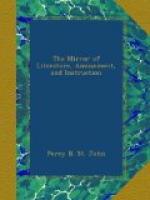Increase and Diminution of Velocity.—Twisting the fibres of wool by the fingers would be a most tedious operation; in the common spinning-wheel the velocity of the foot is moderate; but, by a very simple contrivance, that of the thread is most rapid. A piece of cat-gut passing round a large wheel, and then round a small spindle, effects this change. The small balls of sewing cotton, so cheap and so beautifully wound, are formed by a machine on the same principle, and but a few steps more complicated. The common smoke-jack is an instrument in which the velocity communicated is too great for the purpose required, and it is transmitted through wheels which reduce it to a more moderate rate.
Extending the Time of Action in Forces.—The half-minute which we daily devote to the winding up of our watches is an exertion of labour almost insensible; yet, by the aid of a few wheels its effect is spread over the whole twenty-four hours. Another familiar illustration may be noticed in our domestic furniture: the common jack by which our meat is roasted, is a contrivance to enable the cook in a few minutes to exert a force which the machine retails out during the succeeding hour in turning the loaded spit.
Saving Time in natural Operations.—The process of tanning formerly occupied from six months to two years; this time being apparently required in order to allow the tanning matter to penetrate into the interior of a thick hide. The improved process consists in placing the hides with the solution of tan in close vessels, and then exhausting the air. The consequence of this is to withdraw any air which might be contained in the pores of the hides, and to employ the pressure of the atmosphere to aid capillary attraction in forcing the tan into the interior of the skins. The effect of the additional force thus brought into action can be equal only to one atmosphere, but a further improvement has been made: the vessel containing the hides is, after exhaustion, filled up with a solution of tan; a small additional quantity is then injected with a forcing-pump. By these means any degree of pressure may be given which the containing vessel is capable of supporting, and it has been found that, by employing such a method, the thickest hides may be tanned in six weeks or two months.
Printing from Wooden Blocks.—A block of box-wood is, in this instance, the substance out of which the pattern is formed: the design being sketched upon it, the workman cuts away with sharp tools every part except the lines to be represented in the impression. This is exactly the reverse of the process of engraving on copper, in which every line to be represented is cut away. The ink, instead of filling the cavities cut in the wood, is spread upon the surface which remains, and is thence transferred to the paper.




